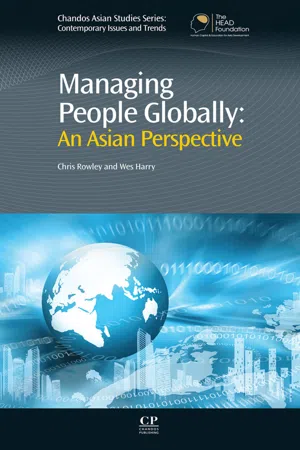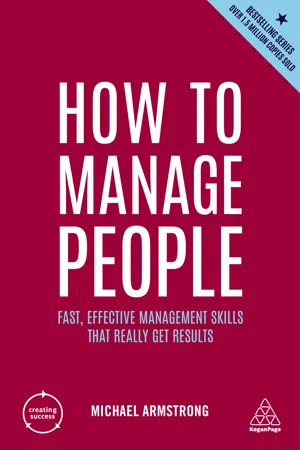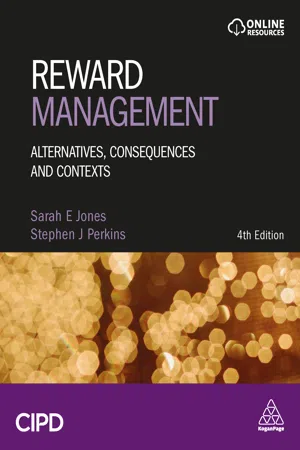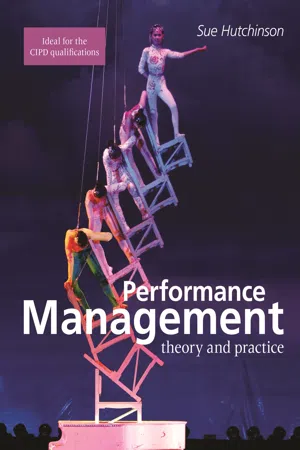Employee Rewards
Employee rewards refer to the incentives and recognition given to employees in return for their performance and contribution to the organization. These rewards can include monetary bonuses, promotions, awards, and non-monetary benefits such as flexible work hours or additional vacation time. Effective employee rewards can boost morale, motivation, and productivity within the workforce.
8 Key excerpts on "Employee Rewards"
- eBook - ePub
Introduction to Human Resource Management
A Guide to HR in Practice
- Charles Leatherbarrow, Janet Fletcher(Authors)
- 2018(Publication Date)
- CIPD - Kogan Page(Publisher)
...12 Employee reward LEARNING OBJECTIVES After studying this chapter, you should be able to: describe the concept of employee reward; show how reward is managed, in terms of the organisation’s reward policies, systems and procedures; explain what is meant by financial, non-financial and total reward; recognise that the link between reward and motivation is complex; understand a range of payment systems and make meaningful contributions to their development and implementation; identify key legislation that has impacted upon how people are rewarded and the requirements placed upon organisations with respect to ‘gender gap’ and ‘equal pay’ reviews. Defining reward It is not possible to define reward in a single statement because perceptions of it vary from one person to another and from one situation to another. A manager, for example, might define reward as ‘the payment that an employee receives in accordance with the value of his or her work contribution to the organisation’. An employee, on the other hand, may say that it is ‘the return that he or she receives on the investment of his or her time, knowledge, skills, loyalty and commitment’. Non-financial factors such as the benefits and facilities that the organisation offers to its employees are integral to the concept of reward, as are recognition, praise and career development. Perkins, White and Jones (2016, p5), citing Milkovich and Newman write the following, when defining reward, ‘Employee “compensation”, “remuneration” or “reward” (terms used interchangeably in the literature) may be defined as “all forms of financial returns and tangible services and benefits employees receive”.’ HRM and reward According to Pointon and Ryan (2004), ‘reward management’ has often been viewed as the ‘poor relation’ of HRM, being concerned with ‘systems, figures and procedures’...
- eBook - ePub
The WorldatWork Handbook of Compensation, Benefits and Total Rewards
A Comprehensive Guide for HR Professionals
- (Author)
- 2015(Publication Date)
- Wiley(Publisher)
...A properly structured total rewards package sends a key message—by aligning all the components of total rewards with the overall business vision, a company ensures its workforce is on the same page. FIGURE 1.1 Total rewards: different things to different employers. Given these factors, it is not surprising that a broader definition is gaining favor in the marketplace. Companies still need to decide how broadly they want to define total rewards, based on what they can adequately measure and manage. Sidebar 1.1 : How We Define It For the purposes of this book, the term total rewards refers to everything that employees value in the employment relationship (i.e., everything an employee gets as a result of working for the company). WorldatWork defines total rewards as the monetary and nonmonetary return provided to employees in exchange for their time, talents, efforts, and results. It involves the deliberate integration of five key elements that effectively attract, motivate, and retain the talent required to achieve desired business results. The five key rewards elements are: Compensation. Benefits. Work-Life. Performance and Recognition. Development and Career Opportunities. Total rewards strategy is the art of combining these five elements into tailored packages designed to achieve optimal motivation...
- eBook - ePub
Managing People Globally
An Asian Perspective
- Chris Rowley, Wes Harry(Authors)
- 2011(Publication Date)
- Chandos Publishing(Publisher)
...come in many varieties. Think About/Question 3.2 What different components of rewards are you familiar with? The broad aspects of rewards can be seen as comprising the elements shown in Table 3.2. Table 3.2 Elements of rewards Aspects of rewards Examples Money Salary, bonus and incentives, expenses Benefits Pension, cars, housing, insurance, leave, medical facilities Work Challenge, autonomy, environment Development Training, personal development, employability, job security People require rewards for the services they provide for the organisation. In taking a job a person must work and forsake time which could be occupied with other activities. Therefore, organisations ‘compensate’ for the time lost and the efforts put in by individuals to carry out the tasks and duties of a job. This is why US organisations, in particular, refer to pay systems as ‘compensation’. Compensation comes in two main forms: intrinsic and extrinsic. 3.4.1 Intrinsic rewards These rewards relate to the inner satisfactions experienced in carrying out the tasks and duties of a job. These satisfactions may be small or large, depending on factors such as the degree of interest in the work, conditions, opportunities and recognition. Intrinsic rewards may not usually be sufficient to induce someone to take a job and remain in it, although people may accept lesser extrinsic reward if the intrinsic satisfactions of a job are obvious and substantial. Charity workers, such as those based in Malaysia and India, for example, may chose a vocation which pays less than they could expect from other career choices...
- eBook - ePub
How to Manage People
Fast, Effective Management Skills that Really Get Results
- Michael Armstrong(Author)
- 2022(Publication Date)
- Kogan Page(Publisher)
...The system itself consists of the arrangements for grading jobs, deciding on rates of pay and reviewing pay levels, grade and pay structures, methods of progressing pay such as performance-related pay, and employee benefits such as pension schemes and sick pay. If you want to play your part in managing the reward system you must understand how it works. You should be told this by HR but, if not, it’s up to you to find out. Approaches to rewarding people You need to know the factors that determine the effectiveness of the formal or informal system in terms of how well it contributes to the motivation and engagement of employees. These factors consist of the use of both financial and non-financial rewards (a total reward system) and how the system is operated as a fair, equit-able, consistent and transparent approach to rewarding people. Financial and non-financial rewards Financial rewards consist of the rate for the job (base pay), pay related to performance or contribution (merit pay) and benefits such as pension schemes. To be effective such rewards should be perceived as fair, equitable and consistent. They will work better if the system is transparent. People should expect that their efforts will lead to a worthwhile reward. There must also be a ‘line of sight’ between what they do and what they get, between the effort and the reward. Daniel Pink (2009) produced a comprehensive critique of financial rewards, listing the following seven deadly sins: They can extinguish intrinsic motivation. They can diminish performance. They can crush creativity. They can crowd out good behaviour. They can encourage cheating, shortcuts and unethical behaviour. They can become addictive. They can foster short-term thinking. Non-financial rewards can provide a better basis for valuing people because they are more under your control. Financial rewards are restricted by financial budgets and company procedures...
- eBook - ePub
Reward Management
Alternatives, Consequences and Contexts
- Stephen J Perkins, Sarah Jones(Authors)
- 2020(Publication Date)
- CIPD - Kogan Page(Publisher)
...07 Benefits LEARNING OUTCOMES At the end of this chapter you should understand and be able to explain the following: the purpose of employee benefits within the reward system; the origins of and influences upon the provision of employee benefits; benefits strategy and the role of tax and National Insurance in the design of benefits; the various types of employee benefit and their different roles; single status and harmonisation; the major benefits provided; flexible or ‘cafeteria’ benefits; voluntary benefits; salary sacrifice schemes. CIPD REWARD MANAGEMENT MODULE (7RWM) LEARNING OUTCOMES Learners will be able to: Critically discuss traditional, contingent and knowledge bases for transactional and relational rewards. Design internally consistent reward structures that recognise labour market and equity constraints. Critically evaluate key issues in reward management. Employee benefits (or ‘conditions of service’ or ‘fringe benefits’, as they are sometimes termed) are those additional parts of the remuneration package that are not cash pay. Although these benefits may not be part of the monthly or weekly pay statement, they clearly have a cost to the employer and a value to the recipient. It is often estimated that employee benefits can comprise up to 40 per cent of the costs to organisations of employing staff. In some cases, despite being seen as non-cash items, they are received in cash form (such as sick pay, maternity pay or redundancy pay). In the case of pensions, they are often viewed as a form of ‘deferred remuneration’ in that the employee saves part of his or her annual income towards a guaranteed future income when retired. We deal with pensions, which are of increasing importance within reward systems, in Chapter 8. In this chapter we consider first the current absence of both theory and research on employee benefits before proceeding to look at their historical growth and the contextual issues driving benefits provision...
- Iain Henderson(Author)
- 2017(Publication Date)
- CIPD - Kogan Page(Publisher)
...CHAPTER 7 Managing rewards ‘It’s not money that brings happiness, it’s lots of money’ (Russian proverb, cited by Guthrie 2007). INTRODUCTION Rewards, both financial and other, are of obvious importance to employees and employers. One of the central changes which HRM has brought about in management thinking is that it is no longer enough for employers to think in terms of the old common-law principle of ‘a fair day’s pay for a fair day’s work’. Employee commitment and motivation are so important in today’s competitive, knowledge-based world that rewards have to be actively managed to secure the maximum utilisation of human assets, and to attract, motivate and retain core employees. HRM has introduced the term ‘reward management’ to replace simple ‘wage and salary administration’. LEARNING OUTCOMES On completion of this chapter you should: have an appreciation of the main types of payment systems, including performance-related pay l understand non-pay benefits appreciate the concept of reward management understand the principles of job evaluation. Probably the single most significant change in reward management in the UK in the last 30 years has been the extension of performance-related pay beyond the shop floor to white-collar and professional staff, who traditionally were paid straightforward salaries. Both employees and employers are always concerned about issues of reward and performance. So far as rewards are concerned, employees are most concerned about perceived fairness. Employers seek control and minimisation of costs combined with capacity to offer attractive packages to core staff...
- eBook - ePub
Performance Management
Theory and Practice
- Susan Hutchinson(Author)
- 2013(Publication Date)
- CIPD - Kogan Page(Publisher)
...Some individual results-based schemes (eg piecework) have a very short time period (eg a shift, a day, or a week) in contrast to organisation-based schemes (eg share options) which normally require longer time-frames (a year or more). The final issue concerns the form of the reward, such as cash, company shares, or non-financial benefits (for example, holidays, recognition, learning and development opportunities and greater responsibility). The most common form is cash, based on the assumption that money is a key motivator, although many challenge this assumption (see Chapter 3), and there is no doubt that non-financial rewards can also incentivise. Non-financial rewards are also a fairly cost-effective way of improving performance, and can say a lot about the culture and values of the organisation, as in the case of Nationwide (see Case Study 8.1 below). Arguably, the use of this form of reward is under-developed, although the growth in the practice of ‘total reward’ policies which encompasses the tangible and intangible elements of reward suggests that employers are starting to recognise that pay is not the only motivator. REWARDING STAFF AT NATIONWIDE BUILDING SOCIETY At Nationwide, recognition is one of the preferred ways of motivating staff, in keeping with the values of the Society. In the branches a team bonus is based on performance targets and takes the form of reward vouchers rather than cash. This is not only cost-effective but a popular way of rewarding staff. High-performance league competitions are run under the title of the ‘Diamond Club’ scheme, rewarding top-performing branches, areas and individuals on a monthly and annual basis. Branches compete within the same grade (based on a branches grading model) and winners receive a visit from the executive or divisional director, who presents a team plaque or individual award certificate and pin badge...
- eBook - ePub
Business
The Ultimate Resource
- Bloomsbury Publishing(Author)
- 2011(Publication Date)
...They work collaboratively with employees and make conscious decisions to join forces instead of subordinating or dominating. As newer systems such as skill-based pay, total-reward programs, pay-for-performance plans, and open-book management become more mainstream, the challenge for management will be to avoid any suggestion that they are manipulative or disrespectful. In fact, placing too much emphasis on pay and pay systems will detract from the intrinsic value of work itself. WORK AS ITS OWN REWARD Recognizing the short-term nature of employment and the need to influence peak performance, organizations have generated elaborate programs to motivate employees, including informal awards (spontaneous shows of appreciation, thank-you gifts for special services) and formal awards (bonuses, prizes, trophies, service awards). These are all extrinsic awards, providing recognition by means of factors external to the work itself; other examples include: • base-pay packages • variable pay plans • incentives • cash and cash equivalents • benefits • gain-sharing plans • profit-sharing plans • commissions • stock options • alternative pay programs Intrinsic rewards, by contrast, are inherent to the nature of the work itself and the context or environment in which it is performed. They are innately energizing and satisfying, either because the work is pleasurable or because it fulfills individuals’ desire to support the organization’s mission or value system or their own relationships with coworkers. Enlightened managers know the importance of responsibility, respect, recognition, and relationships; these are intrinsically rewarding. In the rush to motivate employees, any number of managers have invested heavily in extrinsic rewards, overlooking the enormous value of intrinsic rewards. Indeed, one intrinsic value of work is that at some level it is a creative expression of self. That’s why some people “love” their work. It helps them feel a sense of mission in their life...







